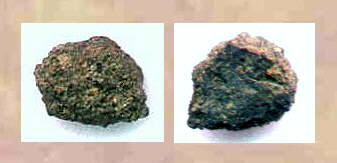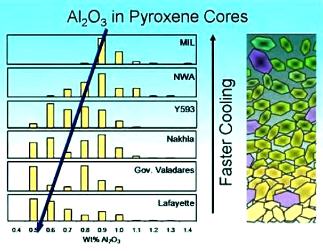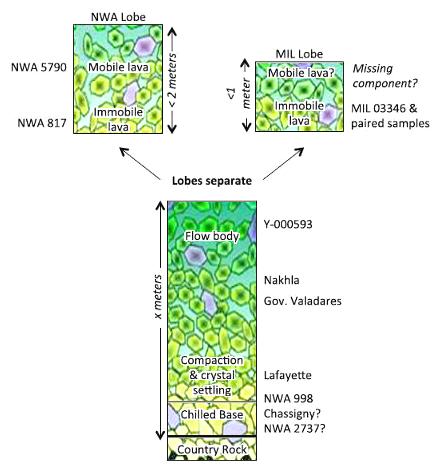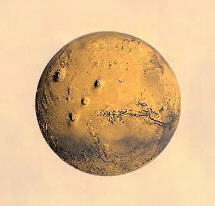NWA 998
Martian NakhliteOne of the Martian SNC meteorites, nakhlites are basaltic cumulate clinopyroxenite rocks, and most all are comprised mainly of sub-calcic augite with approximately 10% Fe-rich olivine (giving the augite a green color) that are set in a very fine-grained matrix (mesostasis) comprised of plagioclase, K-feldspar, clinopyroxene, Fe-Ti oxide (Ti-magnetite), sulfide, Click on Term to Read More
Clinopyroxenite
Purchased 2001
no coordinates recorded A 456 g nakhlite, said to have been found by Berber nomads in western Algeria or possibly eastern Morocco, was brought to the attention of Tucson meteoriteWork in progress. A solid natural object reaching a planet’s surface from interplanetary space. Solid portion of a meteoroid that survives its fall to Earth, or some other body. Meteorites are classified as stony meteorites, iron meteorites, and stony-iron meteorites. These groups are further divided according to their mineralogy and Click on Term to Read More dealers M. Farmer and J. Strope in September 2001. The acquisition of the meteorite was finalized at the 2002 Tucson Gem and MineralInorganic substance that is (1) naturally occurring (but does not have a biologic or man-made origin) and formed by physical (not biological) forces with a (2) defined chemical composition of limited variation, has a (3) distinctive set of of physical properties including being a solid, and has a (4) homogeneous Click on Term to Read More Show, after which a type specimen was provided to the Field Museum of Natural History in Chicago. The main massLargest fragment of a meteorite, typically at the time of recovery. Meteorites are commonly cut, sliced or sometimes broken thus reducing the size of the main mass and the resulting largest specimen is called the "largest known mass". Click on Term to Read More was subsequently acquired by A. and G. Hupé. Northwest Africa 998 was analyzed at the University of Washington, and among other unique features, it is distinguished as the first orthopyroxene-bearing nakhlite.
Northwest Africa 998 shares many characteristics with Nakhla and the other nakhlites, including a similar mineral compositional range and O-isotopic composition. Modally, it consists primarily of olive-green, chemically-zoned, magnesian augiteHigh-Ca clinopyroxene, (Ca,Mg,Fe)SiO3, that occurs in many igneous rocks, particularly those of basaltic composition. In order to be considered augite, the clinopyroxene must contain 20 to 45 mol % of calcium (Wo20 - 45). An important and unique Martian meteorite is NWA 8159, that has been classified as an augite basalt. Click on Term to Read More (~75%) and ferroan olivineGroup of silicate minerals, (Mg,Fe)2SiO4, with the compositional endpoints of forsterite (Mg2SiO4) and fayalite (Fe2SiO4). Olivine is commonly found in all chondrites within both the matrix and chondrules, achondrites including most primitive achondrites and some evolved achondrites, in pallasites as large yellow-green crystals (brown when terrestrialized), in the silicate portion Click on Term to Read More (~9%), along with plagioclaseAlso referred to as the plagioclase feldspar series. Plagioclase is a common rock-forming series of feldspar minerals containing a continuous solid solution of calcium and sodium: (Na1-x,Cax)(Alx+1,Si1-x)Si2O8 where x = 0 to 1. The Ca-rich end-member is called anorthite (pure anorthite has formula: CaAl2Si2O8) and the Na-rich end-member is albite Click on Term to Read More (~7%), orthopyroxeneOrthorhombic, low-Ca pyroxene common in chondrites. Its compositional range runs from all Mg-rich enstatite, MgSiO3 to Fe-rich ferrosilite, FeSiO3. These end-members form an almost complete solid solution where Mg2+ substitutes for Fe2+ up to about 90 mol. % and Ca substitutes no more than ~5 mol. % (higher Ca2+ contents occur Click on Term to Read More (~3.5%), and titanomagnetite (~1%), plus minor amounts of alkali feldsparVariety of feldspar containing alkali metals potassium and sodium in a solid solution. A more complete explanation can be found on the feldspar group page that also includes the plagioclase feldspars as part of the feldspar ternary diagram. Click on Term to Read More, chlorapatite, and pyrrhotiteIron sulfide group of minerals whose composition ranges widely between its end members pyrrhotite (Fe7S8) whose crystal structure is monoclinic, and troilite (FeS) whose crystal structure is hexagonal. Its general formula is Fe1−xS (where x = 0 to 0.17). The troilite phase is found mainly in meteorites and in the Click on Term to Read More, all forming a loosely consolidated, friable texture. The formation of orthopyroxene in NWA 998 is attributed to sub-solidus changes along olivine-plagioclase grain boundaries related to temperature or redoxOxidation and reduction together are called redox (reduction and oxidation) and generally characterized by the transfer of electrons between chemical species, like molecules, atoms or ions, where one species undergoes oxidation, a loss of electrons, while another species undergoes reduction, a gain of electrons. This transfer of electrons between reactants Click on Term to Read More state, or to silicateThe most abundant group of minerals in Earth's crust, the structure of silicates are dominated by the silica tetrahedron, SiO44-, with metal ions occurring between tetrahedra). The mesodesmic bonds of the silicon tetrahedron allow extensive polymerization and silicates are classified according to the amount of linking that occurs between the melt infusion (Breton and Lee, 2015). The fact that NWA 998 has the lowest REEOften abbreviated as “REE”, these 16 elements include (preceded by their atomic numbers): 21 scandium (Sc), 39 Yttrium (Y) and the 14 elements that comprise the lanthanides excluding 61 Promethium, an extremely rare and radioactive element. These elements show closely related geochemical behaviors associated with their filled 4f atomic orbital. Click on Term to Read More abundance of any nakhlite might be attributable to its low retention of intercumulus magmaMolten silicate (rock) beneath the surface of a planetary body or moon. When it reaches the surface, magma is called lava. Click on Term to Read More, which is reflected in its small volume of mesostasisLast material to crystallize/solidify from a melt. Mesostasis can be found in both chondrules, in the matrix around chondrules, and in achondrites as interstitial fine-grained material such as plagioclase, and/or as glass between crystalline minerals. Click on Term to Read More (~2%). This virtual lack of mesostasis defines NWA 998 in the strict sense as the only cumulateIgneous rock composed of crystals that have grown and accumulated (often by gravitational settling) in a cooling magma chamber. Click on Term to Read More among the nakhlites. The occurrence of orthopyroxene in NWA 998, mostly associated with olivine-plagioclase grain boundaries, has also been identified in Lafayette (McCubbin et al., 2013). Although veinlets of orange-colored alteration product (‘iddingsite’) observed within olivine grains are considered to be pre-terrestrial in origin, an extensive 6,000 (±1,000) year terrestrial residence has resulted in some minor Fe staining and the formation of veinlets composed of other alteration products.
A Sm–Nd isotopic plot for NWA 998 establishes an isochron at 1.29 (±0.05) b.y., while a refined Ar–Ar age was calculated at 1.334 (±0.011) b.y., ages which are virtually identical to six other nakhlites studied (Nakhla, Lafayette, Governador Valadares, NWA 817, Y-000593 pairing group, and MIL 03346 pairing group). Based on all available age data for all studied nakhlites (excluding NWA 817), Park et al. (2009) presented a combined isochron reflecting an age of 1.325 (±0.018) b.y. The shielding-corrected CRE age for NWA 998 (14.5 m.y. and 13.0 m.y. based on 21Ne and 3He, respectively) is also identical to that of the other studied nakhlites, suggesting all were ejected from Mars in a single impact event from a common source. Notably, this impact produced features commensurate with relatively low shock.
A significant difference between Nakhla and NWA 998 can be seen in the rims surrounding augite grains. In NWA 998, they consist of orthopyroxene rather than the pigeoniteLow-Ca clinopyroxene, (Ca,Mg,Fe)SiO3, found as a major mineral in eucrites and shergottites. In order to be considered pigeonite, the clinopyroxene must contain 5 to 20 mol % of calcium (Wo5 - 20). Chondrites of petrologic types 4 and below contain significant low-Ca clinopyroxene. During metamorphism to higher temperatures, all existing in the Nakhla rims. Also unique to NWA 998 are miniscule melt inclusions along fractures in pyroxeneA class of silicate (SiO3) minerals that form a solid solution between iron and magnesium and can contain up to 50% calcium. Pyroxenes are important rock forming minerals and critical to understanding igneous processes. For more detailed information, please read the Pyroxene Group article found in the Meteoritics & Classification category. Click on Term to Read More consisting of alkali-bearing silicaSilicon dioxide, SiO2. glass and rare Fe-bearing (‘ankeritic’) carbonate. Other minerals which are present in fractures and along grain boundaries of augite include Fe–Mg–Ca-bearing carbonates, K-feldspar, and phyllosilicate; the phyllosilicate phase has been shown to be a replacement for carbonateMineral or compound containing carbon and oxygen (i.e. calcium carbonate, CaCO3, calcite). Click on Term to Read More (sideriteAn obsolete term for an iron meteorite.), which had previously been formed as a replacement for olivine during periods of increased CO2 and water (Tomkinson et al., 2013).
Olivines in nakhlites typically contain lamellar inclusions of magnetiteFe oxide, Fe2+Fe3+2O4, containing oxidized iron (Fe3+) found in the matrix of carbonaceous chondrites and as diagnostic component in CK chondrites. In CK chondrites, magnetite is typically chromian, containing several wt. % Cr2O3. Click on Term to Read More and augite known as symplectites, which were formed through exsolutionSegregation, during cooling, of a homogeneous solid solution into two or more different solids. Click on Term to Read More processes, precipitated by the contractive cooling (from above 900°C) of Fe+3-bearing olivine grains. Symplectites in Nakhla constitute ~1 vol% of the mass, and they are found both along olivine grain boundaries and within the olivine grains. By contrast, symplectites in NWA 998 are found only at olivine grain boundaries. Furthermore, the magnetite in NWA 998 symplectites contains titanium, while none has been observed in Nakhla. Nearly identical symplectites have been identified in Governador Valadares, as well as in the genetically-related Chassigny, but none have been found in Lafayette. HydrogenLightest and most common element in the universe (~92% by atoms; ~75% by mass). Hydrogen's isotopes are: • 1H (99.9885 %)
• 2H (0.0115 %), also called deuterium.
• 3H, also called Tritium, is a radioactive (t½ = 12.32 y) by-product of atmospheric thermonuclear tests in Earth's hydrosphere and atmosphere.
Click on Term to Read More isotopeOne of two or more atoms with the same atomic number (Z), but different mass (A). For example, hydrogen has three isotopes: 1H, 2H (deuterium), and 3H (tritium). Different isotopes of a given element have different numbers of neutrons in the nucleus. Click on Term to Read More studies of melt inclusions, olivine, and clinopyroxene in NWA 998 show an extraterrestrial signature with an enriched D value (Boctor et al., 2005). However, studies of NWA 998 apatite derived from late-stage, open systemDefinable part of the universe that can be open, closed, or isolated. An open system exchanges both matter and energy with its surroundings. A closed system can only exchange energy with its surroundings; it has walls through which heat can pass. An isolated system cannot exchange energy or matter with magma movement suggest that very little water was present in its parent magma, ~0.07–0.11 wt% (Treiman and Irving, 2008; Channon et al., 2011). Conversely, results of analyses of both apatite and amphibole in martian meteorites are consistent with a magma volatileSubstances which have a tendency to enter the gas phase relatively easily (by evaporation, addition of heat, etc.). content high in chlorine (Filiberto and Treiman, 2009). Still, McCubbin et al. (2009) found that kaersutite and Ti-biotite in Chassigny melt inclusions contain higher abundances of water than previously measured, a value which correlates to a parental source magma water content of ~460–840 ppmParts per million (106). Click on Term to Read More (0.5–0.8 wt%), while lower abundances of Cl and F were observed. However, it is now thought that dehydration of the magma resulting from the infiltration of an exogenous Cl-rich fluid occurred after the crystallizationPhysical or chemical process or action that results in the formation of regularly-shaped, -sized, and -patterned solid forms known as crystals. Click on Term to Read More of the chassignitesThe group is part of the SNC martian trio and named after the meteorite seen to fall in Chassigny, France, in 1815. Its subsequent recovery led to it being one of the first meteorites to be recognized as a genuine rock from space. Chassigny resembles a terrestrial dunite - a Click on Term to Read More (McCubbin et al., 2013).
Several competing scenarios have been presented to explain the formation of nakhlites. Some scenarios place their origin in a plutonicGeology: Igneous intrusive body that forms when magma is injected into host rocks and solidifies. Plutons occur in the crust of asteroids undergoing differentiation or planets. Named after Pluto, the Roman god of the underworld. Plutonic rocks are the rocks found within a pluton. Astronomy: Category of planet including all Click on Term to Read More environment, while others place it close to the surface in a thick lavaHot molten or semifluid rock derived from a volcano or surface fissure from a differentiated and magmatically active parent body. Click on Term to Read More flow or a shallow intrusion, such as a dikePlanar, blade-like, intrusive igneous body that cuts across preexisting layers usually at a high-angle to near-vertical orientation. By definition, a dike is always younger than the rocks that contain it. Terrestrial dikes are typically 0.5 to 3 m wide and extend for a few 10s of kilometers. Click on Term to Read More or sill. Following are details of three of the major competing scenarios:
Scenario 1
- a two-stage evolution of nakhlites began with the formation of pyroxene-rich cumulates during an early Mars differentiationA process by which a generally homogeneous chondritic body containing mostly metal, silicates and sulfides will melt and form distinct (differentiated) layers of different densities. When the melting process continues for a long enough period of time, the once chondritic body will re-partition into layers of different composition including Click on Term to Read More period ~4.56 b.y. ago.
- a late magmatic event ~1.3 b.y. ago resulted in the partial meltingAn igneous process whereby rocks melt and the resulting magma is comprised of the remaining partially melted rock (sometimes called restite) and a liquid whose composition differs from the original rock. Partial melting occurs because nearly all rocks are made up of different minerals, each of which has a different melting Click on Term to Read More of the cumulate mantleMain silicate-rich zone within a planet between the crust and metallic core. The mantle accounts for 82% of Earth's volume and is composed of silicate minerals rich in Mg. The temperature of the mantle can be as high as 3,700 °C. Heat generated in the core causes convection currents in Click on Term to Read More and the crystallization of augite from the parent magma.
- basaltic melt inclusions were then entrapped within olivine crystals, showing that the intercumulus magma was rich in Fe and Ca, poor in Al and Ti, enriched in K relative to Na, and similar to alkaline basalts on Earth.
- the rapid growth of augite and olivine was followed by a period of slow cooling, gravitational settling, and equilibration within a plutonic environment, forming a cumulus-textured solid.
- continued percolation of intercumulus magma resulted in extensive late-magmatic re-equilibration at temperatures of ~750 °C under increasingly more oxidizingOxidation and reduction together are called redox (reduction and oxidation) and generally characterized by the transfer of electrons between chemical species, like molecules, atoms or ions, where one species undergoes oxidation, a loss of electrons, while another species undergoes reduction, a gain of electrons. This transfer of electrons between reactants Click on Term to Read More conditions, which promoted the replacement of olivine by low-Ca pyroxene + magnetite.
- lastly, a more rapid final cooling phase occurred, with solidification possibly taking place nearer the surface, perhaps in a lava flow or sill.
Scenario 2 This scenario utilizes the 2.7 b.y. old, differentiated, surface lava flow in Ontario, Canada known as Theo’s Flow as an analog for the nakhlites. In particular, the differentiated, 60 m thick pyroxenite layer is so similar to the nakhlites that it is proposed they share the same formation processes.
- initially a very maficOne of the two broad categories of silicate minerals, the other being felsic, based on its magnesium (Mg) and/or iron (Fe) content. Mafic indicates silicate minerals that are predominantly comprised of Mg and/or Fe.The term is derived from those major constituents: Magnesium + Ferrum (Latin for iron) + ic (having Click on Term to Read More magma flow tens of meters thick began to pool.
- pyroxene nucleation began in a cooler zone underneath a quenched crustal layer which began to link into clusters.
- these pyroxene clusters then sank through the low-viscosity magma only to be carried back up in convectionTransfer of heat energy by moving material. Temperatures increases with depth in planetary objects. Deep hot less-dense material physically rises and cools, releasing heat and becoming denser. The now cooler denser material sinks back into deeper regions, where it will be reheated and rise again. Convection is an important mechanism Click on Term to Read More currents.
- during the few days the pyroxene clusters were in this convective cycle, each cycle lasting for a few hours, they grew larger each time they reached the cooler nucleation zone.
- when the clusters became too heavy for convective forces, they settled out onto the cumulus pile below, where the grains developed a preferred orientation.
- lastly, plagioclase crystallized from trapped low-Al melt, along with a possible unsampled gabbroic layer.
Scenario 3 Perhaps the most plausible scenario for the petrogenesis and comagmatic origin of both the chassignites and nakhlites was proposed by McCubbin et al. (2013), which is based in large part on advanced analytical techniques used to investigate the volatile-bearing minerals present in these two groups.
- a very mafic, depleted partial melt intruded into the near-surface crustOutermost layer of a differentiated planet, asteroid or moon, usually consisting of silicate rock and extending no more than 10s of km from the surface. The term is also applied to icy bodies, in which case it is composed of ices, frozen gases, and accumulated meteoritic material. On Earth, the Click on Term to Read More.
- olivine and chromiteBrownish-black oxide of chromium and iron (Cr-Fe oxide), Cr2FeO4, found in many meteorite groups. Click on Term to Read More were the first cumulus minerals to crystallize within this chamber, composing the most slowly cooled, lowest stratigraphic horizon to become the dunitic chassignites.
- as cooling proceeded, a Cl-rich LREE-enriched fluid infiltrated the chamber leaving the magma enriched in Cl and LREE, and depleted in water.
- the next horizon to crystallize is posited to have been composed of olivine and pigeonite, but a representative sample has not yet been found.
- after the stratographic unit represented by NWA 998 was accumulated, the melt reached the point of Cl saturation, and a low-density, Cl-rich fluid was exsolved/degassed; this fluid migrated upwards initiating an eruptive phase.
- this escaping Cl-rich fluid removed proportionately more Fe+2 than Fe+3, thereby increasing the oxygenElement that makes up 20.95 vol. % of the Earth's atmosphere at ground level, 89 wt. % of seawater and 46.6 wt. % (94 vol. %) of Earth's crust. It appears to be the third most abundant element in the universe (after H and He), but has an abundance only Click on Term to Read More state in the later-crystallizing upper horizons.
- as clinopyroxene and olivine crystallization continued, Cl-rich liquid became trapped as inclusions, subsequently forming apatite and amphibole.
- following crystallization of the cumulate pile and lava flow, alteration by low-temperature aqueous fluids produced secondary mineralMineral that forms through processes such as weathering, and in the case of meteorites can also include pre-terrestrial alteration. Secondary minerals in meteorites that formed during terrestrial weathering include oxides and hydroxides formed directly from metallic Fe-Ni by oxidation, phosphates formed by the alteration of schreibersite, and sulfates formed by Click on Term to Read More phases such as iddingsite.
Sulfide phases present in the mesostasis component of nakhlites consist primarily of pyrrhotite (±chalcopyrite) and rare pentlanditeFe-Ni sulfide, (Fe,Ni)9S8, that is often associated with troilite, and found in the matrix and chondrules of CO, CV, CK and CR chondrites. The color is yellow-bronze with light bronze-brown streak and metallic luster. It typically forms during cooling of magmatic sulfide melts during the evolution of parent silicate melt. The Click on Term to Read More. These sulfides are thought to have precipitated from the parent melt under reducingOxidation and reduction together are called redox (reduction and oxidation) and generally characterized by the transfer of electrons between chemical species, like molecules, atoms or ions, where one species undergoes oxidation, a loss of electrons, while another species undergoes reduction, a gain of electrons. This transfer of electrons between reactants Click on Term to Read More conditions, which concomitantly yielded a high abundance of Fe+3-enriched, skeletal titanomagnetite grains reflecting an overall oxidative chemistry (Chevrier et al., 2011; Franz et al., 2014; Dottin et al., 2018). It is argued that the parental magma assimilated a component of sulfate-bearing crustal regolithMixture of unconsolidated rocky fragments, soil, dust and other fine granular particles blanketing the surface of a body lacking an atmosphere. Regolith is the product of "gardening" by repeated meteorite impacts, and thermal processes (such as repeated heating and cooling cycles). Click on Term to Read More and/or hydrothermal fluid during the late magmatic stage under low-temperature conditions. In addition, it is presumed that sulfate sulfur was concentrated at the bottom (or interior) of the lava flow where the cooling rate was the slowest. ReductionOxidation and reduction together are called redox (reduction and oxidation) and generally characterized by the transfer of electrons between chemical species, like molecules, atoms or ions, where one species undergoes oxidation, a loss of electrons, while another species undergoes reduction, a gain of electrons. This transfer of electrons between reactants Click on Term to Read More processes resulted in sulfide abundances of 530 (±160) ppm in NWA 998 located at the bottom, 210 (±70) ppm in Nakhla located near the middle, and 80 (±25) ppm in NWA 817 located at the top (Chevrier et al., 2011). Similarly, the sulfide grain size varies with the crystallization location within the conjectured shallow sill or thick lava flow. Dottin et al. (2018) posited that photochemical fractionationConcentration or separation of one mineral, element, or isotope from an initially homogeneous system. Fractionation can occur as a mass-dependent or mass-independent process. Click on Term to Read More and degassing of sulfur occurred near the surface, which led to differences in the Δ33S in nakhlites corresponding to their position within the cumulate pile or lava flow(s). Accordingly, the negative Δ33S value, positive δ34S value, and high titanomagnetite abundance of the MIL nakhlites attest to their origin at the base of a lava flow where assimilation of sulfate salts from the soil below would be more favorable (see schematic diagram below). 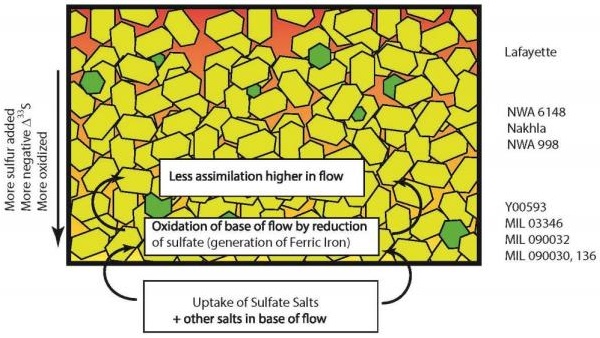
Diagram credit: © J. Dottin III, Master of Science Thesis (2016)
Geology and Earth System Sciences Interdisciplinary Center, University of Maryland, College Park
‘Assessing the Oxidative History of Miller Range Martian Meteorites’
(https://drum.lib.umd.edu/bitstream/handle/1903/18769/DottinIII_umd_0117N_17502.pdf) Based on textural and mineralogical characteristics, including mesostasis (REE) abundance, plagioclase size, olivine Fa composition, intercumulus porosityThe volume percentage of a rock that consists of void space. Vesicular porosity is a type of porosity resulting from the presence of vesicles, or gas bubbles, in igneous rock such as the pumice presented here. Vesicular porosity is very rare in meteorites and is often associated with slag, one Click on Term to Read More, closure temperature, oxygen fugacityUsed to express the idealized partial pressure of a gas, in this case oxygen, in a nonideal mixture. Oxygen fugacity (ƒO2) is a measure of the partial pressure of gaseous oxygen that is available to react in a particular environment (e.g. protoplanetary disk, Earth's magma, an asteroid's regolith, etc.) and Click on Term to Read More, pyroxene composition (Mg#), Fe–Mg and Ca-zoning profiles in olivine and pyroxene, Li zoning profiles in augite, Al-content in pyroxene cores (see diagram below), crystal size distribution analysis, and volatile history, a comparative burial depth within the ~100 m nakhlite pile (both magma chamber and lava flow) for each of the nakhlites and the two chassignites is inferred as follows (Mikouchi et al., 2003, 2005, 2006, 2012, 2014; Lentz and McSween, 2003; Macrì et al., 2004; Imae et al., 2005; Day et al., 2006; McKay et al., 2006; Treiman and Irving, 2008; Jambon et al., 2010; Szymanski et al., 2010; McCubbin et al., 2013; Corrigan et al., 2014; Richter et al., 2015; Hewins et al., 2015; Giesting et al., (2015); Richter et al., 2016; Mikouchi et al., 2017):
-
- NWA 5790/6148: cooling 0.35 to 4.5 °C/hr; 34% mesostasis; olivine Fa94; top of the nakhlite pile, <2 m deep
- MIL 03346 pairing group: cooling 0.04 to 11.0 °C/hr; 22% mesostasis; olivine Fa92; near top, <2 m deep
- NWA 817: cooling 0.5 to 2.2 °C/hr; 24% mesostasis; olivine Fa90; near top, <2 m deep
- Y-000593/749/802: cooling 0.015 to 0.03 °C/hr; 10% mesostasis; olivine Fa85; 7 m deep
- Nakhla: cooling 0.01 to 0.04 °C/hr; 8% mesostasis; olivine Fa72; ~10 m deep
- Governador Valadares: cooling 0.01 to 0.085 °C/hr; 7% mesostasis; olivine Fa70; ~10 m deep
- Lafayette: cooling <0.001 to <0.015 °C/hr; 7% mesostasis; olivine Fa67; up to >30 m deep
- NWA 998: cooling <0.0009 to <0.015 °C/hr; 7–10% mesostasis; olivine Fa62; up to >30 m deep
- unsampled olivine–pigeonite horizon
- NWA 8694: cooling 0.003 to 0.1 °C/hr; olivine Fa46
- Chassigny: cooling 0.003 to 0.1 °C/hr; 7% mesostasis; olivine Fa31
- NWA 2737: cooling 0.003 to 0.1 °C/hr; 6% mesostasis; olivine Fa21; greatest depth (<200 m)
Diagram credit: McKay et al., LPSC 37, #2435 (2006) To account for the difference in trace elementSubstance composed of atoms, each of which has the same atomic number (Z) and chemical properties. The chemical properties of an element are determined by the arrangement of the electrons in the various shells (specified by their quantum number) that surround the nucleus. In a neutral atom, the number of Click on Term to Read More ratios that is observed between the chassignites and the nakhlites, McCubbin et al. (2013) suggested that an exogenous Cl-rich, LREE-enriched fluid was introduced during initial crystallization and accumulation of olivine and chromite, as sampled by the chassignites, and prior to crystallization of clinopyroxene and olivine (±orthopyroxene), as sampled by the nakhlites. Subsequent draining/degassing of this Cl-rich fluid from the accumulating nakhlite pile was accompanied by preferential removal of Fe+2 over Fe+3 from the residual magma, which concurrently increased the oxidationOxidation and reduction together are called redox (reduction and oxidation) and generally characterized by the transfer of electrons between chemical species, like molecules, atoms or ions, where one species undergoes oxidation, a loss of electrons, while another species undergoes reduction, a gain of electrons. This transfer of electrons between reactants Click on Term to Read More of the system. McCubbin et al. (2013) also reasoned that such an infiltration of metasomatic fluid into the chassignite–nakhlite cumulate pile would produce an olivine–pigeonite layer between the chassigniteThe group is part of the SNC martian trio and named after the meteorite seen to fall in Chassigny, France, in 1815. Its subsequent recovery led to it being one of the first meteorites to be recognized as a genuine rock from space. Chassigny resembles a terrestrial dunite - a Click on Term to Read More and nakhlite horizons, although such a lithology is not yet represented in our meteorite collections. Interestingly however, Krzesińska et al. (2017) have identified cumulate pigeonite grains in two small pyroxene-bearing fragments in Chassigny which they infer were derived from this hypothesized olivine–pigeonite layer prior to its final crystallization. Moreover, they found unique µm-scale aggregates associated with these pyroxene-bearing fragments that consist primarily of sulfide phases incorporating µm-sized metallic grains of Pb, Hg, Ag, AuThe astronomical unit for length is described as the "mean" distance (average of aphelion and perihelion distances) between the Earth and the Sun. Though most references state the value for 1 AU to be approximately 150 million kilometers, the currently accepted precise value for the AU is 149,597,870.66 km. The Click on Term to Read More, and Sn. It is considered likely that these metalElement that readily forms cations and has metallic bonds; sometimes said to be similar to a cation in a cloud of electrons. The metals are one of the three groups of elements as distinguished by their ionization and bonding properties, along with the metalloids and nonmetals. A diagonal line drawn Click on Term to Read More grains were introduced to the cumulate pile through the Cl-rich metasomatic fluid.
A re-analysis of the NWA 5790 nakhlite was conducted and published by Jambon et al. (2016). Compared to other nakhlites, the augites in NWA 5790/6148 exhibit unusual zoning features involving FeO/MgO variations, including the presence of micron-scale oscillatory zoning which reflects rapid growth (~1 mm/10 hours) followed by rapid cooling in order to preserve this zoning. Several other features that were observed in this nakhlite, such as discontinuous zoning on augites and rounded augite cores enclosed in olivine, are indicative of a more complex petrogenetic history than has been previously described. To account for the petrography, mineralogy, and geochemistryStudy of the chemical composition of Earth and other planets, chemical processes and reactions that govern the composition of rocks and soils, and the cycles of matter and energy that transport Earth's chemical components in time and space. Click on Term to Read More across the entire nakhlite suite, a new scenario for their petrogenesis was proposed which involves a multi-stage growth history:
- Augite crystallized from an evolved mantle melt and accumulated at the bottom of a sub-surface magma chamber. Multiple melt batches involving variable degrees of fractionation produced the compositional variation observed among the nakhlites.
- Subsequently these augite cumulus crystals (glomerocrysts) were disrupted and entrained by a more evolved magma flow. As a consequence the augites sustained crystal damage and partial resorption.
- This ascending magma erupted to the surface where lower pressures promoted crystallization of olivine, incorporating the augite cores as xenocrysts.
- Growth of olivine continued for a time followed by a final overgrowth of augite, all of which halted when the melt drained away and a rapid cooling stage ensued.
- Multiple successive lava flows ultimately formed a layered cumulate pile with nakhlites within different strataOriginally horizontal layers of rock. exhibiting compositional variability, as illustrated by Jambon et al. (2016) in the diagram below:
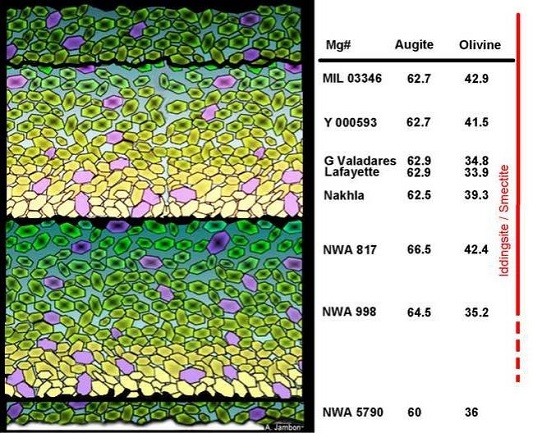
Diagram credit: Jambon et al., GCA, vol. 190, p. 209 (2016)
‘Northwest Africa 5790: Revisiting nakhlite petrogenesis’ (http://dx.doi.org/10.1016/j.gca.2016.06.032) In their scenario, Jambon et al. envision NWA 5790/6148 at the top of the earliest lava flow where the rock experienced very rapid cooling, thereby limiting compaction (reflected in the lowest degree of preferred orientation of augite crystals among nakhlites) and equilibration through diffusionMovement of particles from higher chemical potential to lower chemical potential (chemical potential can in most cases of diffusion be represented by a change in concentration). Diffusion, the spontaneous spreading of matter (particles), heat, or momentum, is one type of transport phenomena. Because diffusion is thermally activated, coefficients for diffusion Click on Term to Read More, and enabling the retention of a relatively large volume of mesostasis. They argue that the final position of NWA 5790/6148 was at the bottom of a stratified cumulate pile, a location which prevented the occurrence of secondary low-temperature hydrous alteration consistent with the absence of ‘iddingsite’ in this nakhlite. In their diagram of the nakhlite cumulate pile, NWA 998 and NWA 817 are located within the intermediate flow zone based on several features they have in common; e.g., they have similar augite coreIn the context of planetary formation, the core is the central region of a large differentiated asteroid, planet or moon and made up of denser materials than the surrounding mantle and crust. For example, the cores of the Earth, the terrestrial planets and differentiated asteroids are rich in metallic iron-nickel. Click on Term to Read More compositions which are distinct from all other nakhlites, they have high incompatible element abundances (similar also to NWA 5790/6148), and they have similar magnetite abundances. The top flow contains those nakhlites with similar augite core compositions as well as those with a high abundance of secondary aqueous alteration minerals; Nakhla is considered to reside near the bottom of this stratum. Chevrier et al. (2011) observed that NWA 998 contains the highest sulfur concentration among the nakhlites, which they found to be consistent with the hypothesis that NWA 998 formed near the bottom of the nakhlite pile where assimilation of sulfur-rich regolith material could take place; this correlation needs to be reconciled with the new scenario proposed by Jambon et al. (2016).
Balta et al. (2016) conducted a geochemical and petrographic study of NWA 5790 which included major, minor, and trace element analyses along with crystal size distribution (CSD) and spatial distribution pattern analyses. Based on this study, a new scenario was presented to explain the formation history of the known nakhlites (excluding the most recently discovered nakhlite NWA 10153 and pairings) and to further characterize the stratigraphic relationship that existed among them, with an emphasis on the three nakhlites generally considered to have crystallized nearest the top of the cumulate pile or lava flow(s)—NWA 5790/6148, MIL 03346 and pairings, and NWA 817. Although previous studies have concluded that NWA 5790/6148 likely formed above MIL 03346 in a common lava flow, Balta et al. (2016) noted that the mesostasis in NWA 5790 and NWA 817 contains a significant abundance of crystalline phases compared to that in MIL 03346; this is consistent with NWA 5790 and NWA 817 cooling more slowly at a deeper location than MIL 03346. Another inconsistency with the location of NWA 5790/6148 at the top of a common cumulate pile or lava flow was demonstrated through their REE analyses. The measured REE abundances in augite rims are higher in MIL 03346 and NWA 817 compared to NWA 5790, which would correspond to a higher degree of fractionation and a higher position in the cumulate pile or lava flow for MIL 03346 and NWA 817. Furthermore, based on both its CSD pattern and small olivine diffusion rims, MIL 03346 appears to have experienced a higher cooling rate nearer the top as compared to NWA 5790. In addition, major and minor element chemistry and petrographic characteristics tend to link NWA 5790 with NWA 817 and distinguish both of them from MIL 03346, making the hypothesis of a single verticle stratigraphic sequence untenable. In consideration of these and other findings (e.g., a sizable ‘iddingsite’ alteration pocket in NWA 5790), Balta et al. (2016) have proposed that these three nakhlites represent separate breakout lobes from a common parental lava flow (see schematic diagram below).
Diagram credit: Balta et al., MAPS, vol. 52, #1, p. 56 (2017) and references therein
‘Northwest Africa 5790: A previously unsampled portion of the upper part of the nakhlite pile’
(http://dx.doi.org/10.1111/maps.12744)
Color background adapted from Jambon et al., GCA, vol. 190, p. 209 (2016)
‘Northwest Africa 5790: Revisiting nakhlite petrogenesis’
(http://dx.doi.org/10.1016/j.gca.2016.06.032) After a precise accounting and correction for the trapped (from martian atmosphere), radiogenic (from in situ 40K), and cosmogenic (from cosmic-ray exposure; weighted mean age = 10.7 [±0.8] m.y.) Ar components in six nakhlites (Lafayette, Y-000593, Y-000749, NWA 5790, Nakhla, and MIL 03346), Cohen et al. (2017) calculated a high-resolution 40Ar/39Ar age for each different nakhlite; they consider that these ages reflect the timing of the respective source lava eruption. The data show that these nakhlites erupted over a timespan of 93 (±12) m.y.—between 1.416 (±0.007) and 1.322 (±0.010) b.y. ago. They suggest that these six nakhlites represent at least four distinct sequential lava flows from a single plume-fed volcano, and that the flows were stratigraphically ordered commensurate with the nakhlite Ar chronometry data (see diagram below). Importantly, because of the incongruent eruption ages of the two Yamato nakhlites—a separation of 70 (±10) m.y.—it can be inferred that their source lithologies on Mars were located far apart, and therefore it is improbable that they are fall-paired. 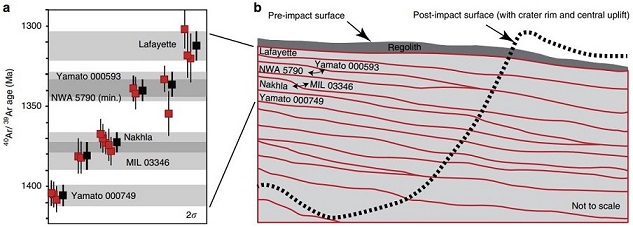
click on image for a magnified view
Diagram credit: Cohen et al., Nature Communications, vol. 8, #640, pp. 1–9 (2017, open access link)
‘Taking the pulse of Mars via dating of a plume-fed volcano’
https://doi.org/10.1038/s41467-017-00513-8 Analyses of the most recent nakhlite findMeteorite not seen to fall, but recovered at some later date. For example, many finds from Antarctica fell 10,000 to 700,000 years ago. Click on Term to Read More, NWA 10153 and pairings, has been published by investigators including Mikouchi et al. (2016, 2017). They report that this nakhlite contains ~25–30% interstitialTerm applied to ions or atoms occupying sites between lattice points. Click on Term to Read More mesostasis similar to the abundances in NWA 817 and MIL 03346 which are considered to have cooled rapidly near the top of the cumulate pile. However, the coarse nature of the feldsparAn alumino-silicate mineral containing a solid solution of calcium, sodium and potassium. Over half the Earth’s crust is composed of feldspars and due to their abundance, feldspars are used in the classification of igneous rocks. A more complete explanation can be found on the feldspar group page. Click on Term to Read More in NWA 10153 (0.2–0.3 mm laths) is similar to that in NWA 998 (0.5 mm laths) which is considered to have cooled slowly near the bottom of the pile. Augite core compositions in NWA 10153 are similar to those of all other nakhlites, consistent with their crystallization from a common parental melt. This nakhlite exhibits complex chemical zoning in olivine and augite—the augite zoning is unlike that in any other nakhlite. Based on the Ca-Fe-Mg zoning profile, the cooling rate was determined to be 0.01–0.05 °C/hr; this is similar to that for Nakhla, GV, and Y-000593, which are considered to have crystallized at an intermediate depth within the pile. While Nakhla and other nakhlites from intermediate depths contain carbonates and halides, these are absent in NWA 10153. Low-temperature secondary aqueous alteration products (silicate gel phase) have been observed in both mesostasis and olivine fractures, a mineralogy common to the nakhlites near the top of the pile (Hicks et al., 2016). Another unique feature of this nakhlite is its significantly higher initial Nd-isotopic values and lower initial Hf-isotopic values compared to other nakhlites (Righter et al., 2016). Because of the ambiguous nature of NWA 10153, its position within a specific stratum in the nakhlite cumulate pile or lava flow(s) has not yet been determined; however, the combined data suggest a separate flow or lobe. A crystal size distribution analysis of nakhlites conducted by Udry and Day (2018) also shows that the NWA 10153 pairing group differs from other nakhlites; pyroxene is texturally much coarser and plagioclase is more abundant, and therefore a separate source lava flow or sill is indicated.
A trace-element analysis conducted by Udry and Day (2018) demonstrates a division of nakhlites into two distinct groups—high trace-element abundance and low trace-element abundance (see diagram below). It is notable that these two groupings are consistent with the two groupings ascertained by Corrigan et al. (2015): 1) Nakhla, Lafayette, Governador Valadares, and the Yamato pairings with low mesostasis abundances and pyroxene–olivine covariance, and 2) NWA 5790 and the MIL pairings with low olivine abundances and pyroxene–mesostasis covariance. Grouping By Trace-Element Abundance
High TE Nakhlites: MIL 03346 pairings, NWA 817, NWA 5790/6148, NWA 10153 pairings, NWA 10645
Low TE Nakhlites: Governador Valadares, Lafayette, Nakhla, NWA 998, Y-000593 pairings
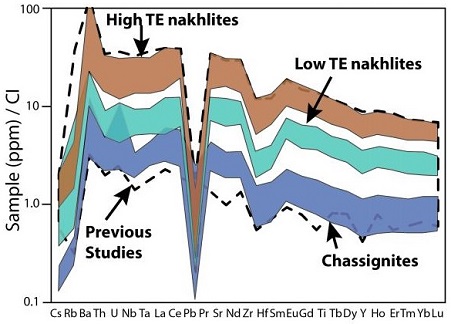
Diagram credit: Udry and Day, 49th LPSC, #1052 (2018)
An in-depth study of nearly all known nakhlites and chassignites was conducted by Udry and Day (2018). The results of petrological and geochemical analyses led them to propose a more complex emplacement scenario for these meteorites involving fractional crystallizationA crystallization process in which minerals crystallizing from a magma are isolated from contact with the liquid. It is a key process in the formation of igneous rocks during the process of magmatic differentiation. Also known as crystal fractionation. Click on Term to Read More and variable cooling rates within subsurface sills/dikes and multiple lava flows/lobes (see schematic illustration below). Some of the reasons for distinguishing at least seven distinct magma units are as follows:
-
- NWA pairing group 1 (NWA 10153, NWA 10659, NWA 10720, and NWA 11013 pairing group):
-
- No carbonates or salts have been observed in NWA 10659, distinguishing it from Lafayette, Governador Valadares, and Nakhla (Hicks et al., 2016)
- NWA 10153 has a distinct initial ε143Nd and ε176Hf isotopic composition compared to the other nakhlites (Righter et al., 2016)
- Contain crystalline plagioclase, low abundances of phenocrysts, and similar pyroxene compositions (Udry and Day, 2018)
- Contain reddish saponitic clay which suggests emplacement and subsequent alteration close to the surface (Hicks et al., 2016)
- Do not fit the general proposed cumulate pile stratigraphy (Udry and Day, 2018)
-
- NWA pairing group 1 (NWA 10153, NWA 10659, NWA 10720, and NWA 11013 pairing group):
-
- NWA 10645:
- Pyroxene shows patchy zoning for Mg that has not been previously observed in nakhlites and chassignites (Udry and Day, 2018)
- Olivine grains are more Fe-rich (Fo13–22) than those in NWA 11013 (Fo13–39) (Udry and Day, 2018)
- Olivine abundances vary from 1.7 vol% in NWA 10645 (Udry and Day, 2018) to 18 vol% in NWA 10153 (Mikouchi et al., 2016)
- Pyroxene grains have acicular rather than prismatic textures and reach lengths of 4 mm, the largest pyroxene grains of all nakhlites (Udry and Day, 2018)
- Contains crystalline and blocky plagioclase, a low content of phenocrysts, and late-stage olivine (Udry and Day, 2018)
- Pyroxene has a shallower crystal size distribution slope (growth history of crystal populations) (Udry and Day, 2018)
- Contains reddish saponitic clay which suggests emplacement and subsequent alteration close to the surface (Hicks et al., 2016)
- NWA 10645:
-
- NWA pairing group 2 (NWA 5790 and NWA 6148):
- Evidence of lower compaction compared to the other nakhlites (Balta et al., 2016)
- Quenched texture indicates likely formation close to the surface (Udry and Day, 2018)
- More evolved and enriched in incompatible elements compared to the other nakhlites (Udry and Day, 2018)
- NWA pairing group 2 (NWA 5790 and NWA 6148):
-
- NWA 817:
- Experienced less compaction than the other nakhlites (Udry and Day, 2018)
- Pyroxene compositions and R-value (grain clustering statistics from SDP analysis) suggest emplacement in a separate flow or sill (Udry and Day, 2018)
- Significant difference in ejection age compared to the other nakhlites and chassignites (7.3 m.y.; Wieler et al., 2016); therefore, NWA 817 possibly originates from a different impact site on Mars (Udry and Day, 2018)
- NWA 817:
-
- Miller Range and Yamato pairing groups:
- Apatite populations are similar (McCubbin et al., 2013)
- Textures are consistent (Udry and Day, 2018)
- Miller Range and Yamato pairing groups:
-
- Nakhla, Governador Valadares, Lafayette, and NWA 998 (the latter might be a separate flow based on apatites; McCubbin et al., 2013):
- Apatite populations are similar (McCubbin et al., 2013)
- Textures are consistent (Udry and Day, 2018)
- Mesostasis abundance is consistent near 10 vol% (Corrigan et al., 2015)
- Nakhla, Governador Valadares, Lafayette, and NWA 998 (the latter might be a separate flow based on apatites; McCubbin et al., 2013):
- Chassigny and NWA 2737 (and NWA 8694):
- Olivines abundances are nearly identical (Udry and Day, 2018)
- Textures and mineral compositions are consistent (Udry and Day, 2018)
Schematic Illustration of Possible Nakhlite Emplacement Settings
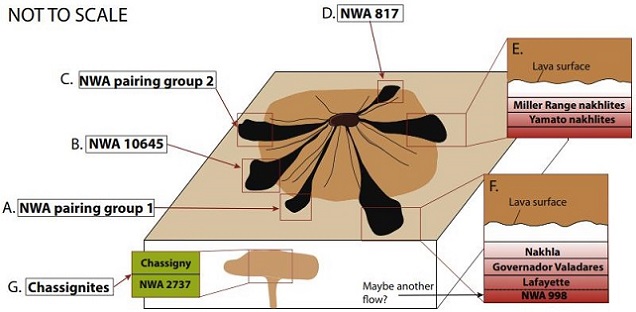
Image credit: Udry and Day, GCA, vol. 238, p. 312 (2018)
‘1.34 billion-year-old magmatism on Mars evaluated from the co-genetic nakhlite and chassignite meteorites’
(https://doi.org/10.1016/j.gca.2018.07.006) Importantly, Mikouchi et al. (2016) found that significant ambiguities also exist among the three known chassignites. Although each chassignite exhibits a similar cooling rate (0.003–0.1 °C/hr), olivine compositions between them show large variations: NWA 8694 is Fa46, Chassigny is Fa31, and NWA 2737 is Fa21. Moreover, each chassignite exhibits a distinct shock history. Therefore, they suggest that each of the chassignites is more likely associated with a separate flow or lobe (possibly within a common extensive igneous unit) rather than a single sequential accumulation (see above diagram illustrating separate lobes as proposed by Balta et al. [2017]).
Based on data from the Infrared Mineralogical Mapping Spectrometer aboard the Mars Express orbiter, olivine-enriched craters in the region of Thaumasia Planum were found to be the best match to the nakhlites (Ody et al., 2013). The high-resolution 40Ar/39Ar mid-Amazonian age determined for six nakhlites by Cohen et al. (2017) led them to the identification of a potential source craterBowl-like depression ("crater" means "cup" in Latin) on the surface of a planet, moon, or asteroid. Craters range in size from a few centimeters to over 1,000 km across, and are mostly caused by impact or by volcanic activity, though some are due to cryovolcanism. Click on Term to Read More (see image below). This 6.5 km-diameter crater is located at 130.799°E, 29.674°N in the Elysium region and was formed in a recent impact event. High-resolution satelliteBody in orbit (such as a moon) around another larger body (such as a planet or star). Click on Term to Read More imagery shows a stratigraphic layering within the walls of the crater, and the calculated depth of ejectaFractured and/or molten rocky debris thrown out of a crater during a meteorite impact event, or, alternatively, material, including ash, lapilli, and bombs, erupted from a volcano. Click on Term to Read More which would have reached escape velocityVelocity that an object needs to escape the primary gravitational influence of a more massive object: where, m = the object's mass, r = distance from object's center, and G = gravitational constant of the larger object. Click on Term to Read More, 40–66 m, is consistent with the depth profile ascertained for the various nakhlites and chassignites. 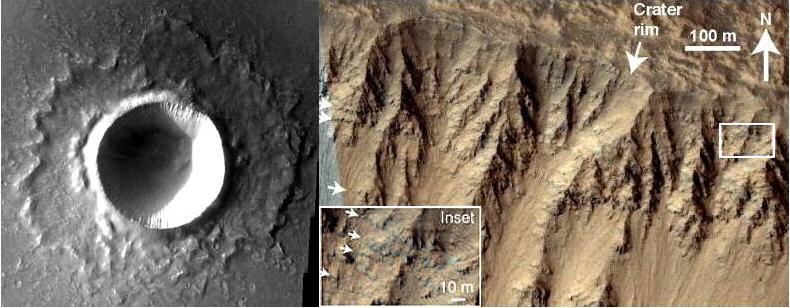
Image credit: Cohen et al., Nature Communications, vol. 8, #640, pp. 1–9 (2017, open access link)
‘Taking the pulse of Mars via dating of a plume-fed volcano’
https://doi.org/10.1038/s41467-017-00513-8 Additional details on the petrogenetic history of the nakhlite group, including the possible presence of martian bacterial micro-fossils, can be found on the Nakhla page. More information and excellent photos of NWA 998 can be found on J. Strope’s website catchafallingstar.com. A transmitted light view of a petrographic thin sectionThin slice or rock, usually 30 µm thick. Thin sections are used to study rocks with a petrographic microscope. of NWA 998 can be seen on J. Kashuba’s page. The specimen shown above is a 0.65 g crusted fragment of NWA 998.






